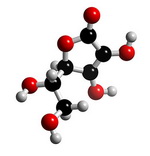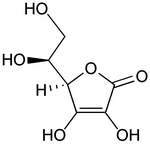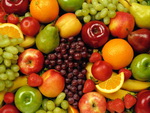|
Vitamin C – The Cure For ScurvyVitamin C is a water soluble vitamin that has two forms one known as ascorbic acid and the other known as dehydroascorbic acid.
Vitamin C Molecule and Chemical Formula 

The vitamin is known as a reducing agent, which is a compound that can donate electrons or hydrogen atoms to another compound, thus the vitamin is also an antioxidant. Although the vitamin is essential to the activities of many enzymes, unlike B complex vitamins it is not a coenzyme. In addition to its role as an antioxidant, the vitamin plays an important role in the synthesis of collagen which is a fibrous protein that helps to reinforce connective tissues that hold together the structures of the body. As a reducing agent the vitamin helps with the absorption of iron which in not related to red blood cells since it comes from plant foods. The vitamin also assists in the synthesis of carnitine a compound that transports fatty acids, and also helps in the synthesis of norepinephrine, epinephrine, serotonin which is a neurotransmitter, thyroxine which is a thyroid hormone, bile acids, steroid hormones, and purine bases used in the synthesis of DNA. The vitamin also helps lymphocytes and other immune system cells to function properly. The vitamin is thought to help to cure the common cold virus, but there is no evidence that this is so, but what appears to be true is that the vitamin can help reduce the duration of a cold. The vitamin also helps to breakdown and clear drugs from the body. Dietary Recommendations The recommended dietary allowance (RDA) for adult men aged 19 and older is 90 milligrams/day and for women aged 19 and older is 75 milligrams/day. For pregnant women the RDA is 85 milligrams/day and for lactating women 120 milligrams/day. It should be noted that smoking increases the metabolic turnover of the vitamin and it is recommended that smokers need 35 milligrams/day more than nonsmokers. Sources of the Vitamin Good sources of the vitamin are citrus fruits, tomatoes, potatoes, fortified foods such as juice drinks, strawberries, kiwifruit, broccoli, spinach, cabbage, leafy green vegetables, and green peppers.
It is interesting that animals can manufacture the vitamin but humans cannot, but humans also require less of the vitamin than do animals.
The vitamin is vulnerable to heat and oxygen. Sources of the Vitamin 

Vitamin Deficiency The most well known deficiency of the vitamin is scurvy with symptoms of bleeding gums, bleeding joints, weakness, small hemorrhages around the hair follicles on the arms and legs. Progression of the disease results in the reopening of healed wounds, bone pain, fractures, diarrhea and psychological problems. Vitamin Toxicity In healthy individuals large doses of the vitamin does not appear to result in toxicity, but taking more than 2000 milligrams/day can result in nosebleeds, nausea, abdominal cramps, and diarrhea. In those with kidney disease excess vitamin can result in kidney stones.
For other information on nutrition, and vitamins in particular some great references are: • Nutrition – Fourth Edition by Paul Insel, Don Ross, Kimberley McMahon, and Melissa Bernstein
Vitamins
|





